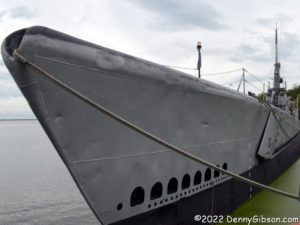 This week my friend Terry and I succeeded in seeing something we’ve been talking about for quite a while. That something is in the picture at right. It’s the USS Cod moored in Cleveland, Ohio. We toured the retired WWII submarine on Tuesday after a leisurely drive to within striking distance on Monday. range the day before. That leisurely drive included a little sightseeing and something of an unplanned adventure.
This week my friend Terry and I succeeded in seeing something we’ve been talking about for quite a while. That something is in the picture at right. It’s the USS Cod moored in Cleveland, Ohio. We toured the retired WWII submarine on Tuesday after a leisurely drive to within striking distance on Monday. range the day before. That leisurely drive included a little sightseeing and something of an unplanned adventure.

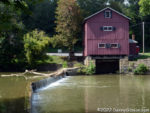
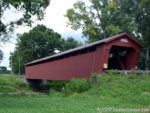 We drove on “America’s Oldest Concrete Street” (1893) in Bellefontaine, then stopped at Indian Mill and crossed over the Parker Covered Bridge near Upper Sandusky.
We drove on “America’s Oldest Concrete Street” (1893) in Bellefontaine, then stopped at Indian Mill and crossed over the Parker Covered Bridge near Upper Sandusky.
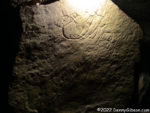
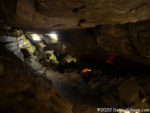
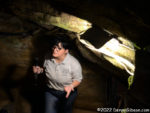 I knew absolutely nothing about Seneca Caverns and Terry knew only that we would be passing nearby. Both of us thought it would be a nice diversion which is exactly the sort of thinking that can lead to, as it did this time, an unplanned adventure. The pictures here are of our guide Allie, a fairly rare horizontal section of the cave, and an elegant 1893 done-by-candlelight inscription.
I knew absolutely nothing about Seneca Caverns and Terry knew only that we would be passing nearby. Both of us thought it would be a nice diversion which is exactly the sort of thinking that can lead to, as it did this time, an unplanned adventure. The pictures here are of our guide Allie, a fairly rare horizontal section of the cave, and an elegant 1893 done-by-candlelight inscription.
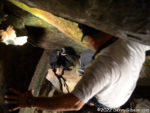
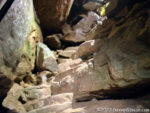
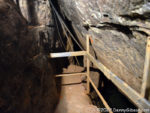 Seneca Caverns is unique among Ohio show caves in being formed by an earthquake crack and by being maintained pretty much in its natural state which explains its nicknames of “Earth Crack” and “Caviest Cave in the USA”. These pictures show Terry and others descending one of the stairways made of natural stones, another natural stone stairway without people, and our farthest penetration (110 feet below the surface) into the cave.
Seneca Caverns is unique among Ohio show caves in being formed by an earthquake crack and by being maintained pretty much in its natural state which explains its nicknames of “Earth Crack” and “Caviest Cave in the USA”. These pictures show Terry and others descending one of the stairways made of natural stones, another natural stone stairway without people, and our farthest penetration (110 feet below the surface) into the cave.

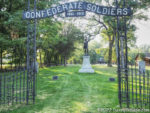
 After returning to the surface, we still had time to check out the cemetery for Confederate soldiers on Johnson’s Island and the nearby Marblehead Lighthouse before ending our day. Confederate prisoners, mostly officers, were kept on the island between April 1862 and September 1865. More than 200 died here and are buried in this cemetery. By the time we arrived, the lighthouse was closed for the day but we were not overly disappointed. Having just climbed up from 110 feet below the Earth’s surface, we didn’t feel a burning need to climb 50 feet above it.
After returning to the surface, we still had time to check out the cemetery for Confederate soldiers on Johnson’s Island and the nearby Marblehead Lighthouse before ending our day. Confederate prisoners, mostly officers, were kept on the island between April 1862 and September 1865. More than 200 died here and are buried in this cemetery. By the time we arrived, the lighthouse was closed for the day but we were not overly disappointed. Having just climbed up from 110 feet below the Earth’s surface, we didn’t feel a burning need to climb 50 feet above it.
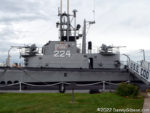 Our short drive to the trip’s primary target was fairly wet but the rain was really letting up by the time we got there and we were headed inside anyway. The USS Cod was commissioned on June 21, 1943, and completed seven successful patrols before the war’s end. Following the war, she served a variety of training roles until 1971 when a group of Clevelanders campaigned to save her from being scrapped. The submarine was turned over to the civilian group in 1976.
Our short drive to the trip’s primary target was fairly wet but the rain was really letting up by the time we got there and we were headed inside anyway. The USS Cod was commissioned on June 21, 1943, and completed seven successful patrols before the war’s end. Following the war, she served a variety of training roles until 1971 when a group of Clevelanders campaigned to save her from being scrapped. The submarine was turned over to the civilian group in 1976.
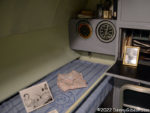

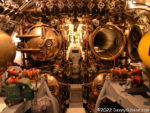 Entry to the submarine’s interior is through a hatch in the forward torpedo room. Stepping back from the torpedo tubes shows folding bunks where crewmen sleep in the space between torpedos. The aft torpedo room is similarly equipped and there are other sleeping areas midship. Other necessities are nearby. The third picture is of the captain’s quarters showing that one’s concept of luxury clearly depends on perspective.
Entry to the submarine’s interior is through a hatch in the forward torpedo room. Stepping back from the torpedo tubes shows folding bunks where crewmen sleep in the space between torpedos. The aft torpedo room is similarly equipped and there are other sleeping areas midship. Other necessities are nearby. The third picture is of the captain’s quarters showing that one’s concept of luxury clearly depends on perspective.
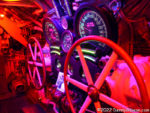
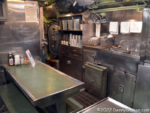
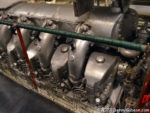 Red light is used to preserve sailors’ night vision and some sections of the Cod are illuminated in red to let visitors see what this was like. Submariners reportedly ate better than any other members of the military. Meals were prepared in this stainless steel galley and most were consumed here. Note the books and games stored near the tables and other entertainment was also available. Movies were sometimes shown in the dining area. One of the four 1,600 HP diesel engines is shown and there is a 500 HP auxiliary engine as well. These engines generate electricity which is stored in batteries to turn the propellers. Two stills at the front of the forward engine room provide fresh water for batteries, drinking, and other uses.
Red light is used to preserve sailors’ night vision and some sections of the Cod are illuminated in red to let visitors see what this was like. Submariners reportedly ate better than any other members of the military. Meals were prepared in this stainless steel galley and most were consumed here. Note the books and games stored near the tables and other entertainment was also available. Movies were sometimes shown in the dining area. One of the four 1,600 HP diesel engines is shown and there is a 500 HP auxiliary engine as well. These engines generate electricity which is stored in batteries to turn the propellers. Two stills at the front of the forward engine room provide fresh water for batteries, drinking, and other uses.
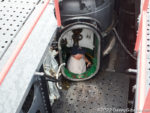 Visitors normally exit the USS Cod through a hatch in the aft torpedo room but that was closed because of the rain. We traveled back through the ship and where we had entered in the forward torpedo room. I exited first and got a picture of Terry climbing the ladder and another proving he made it out.
Visitors normally exit the USS Cod through a hatch in the aft torpedo room but that was closed because of the rain. We traveled back through the ship and where we had entered in the forward torpedo room. I exited first and got a picture of Terry climbing the ladder and another proving he made it out.

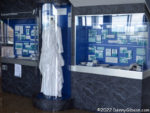 The fellow at the gate of the USS Cod suggested we walk over to the International Women’s Air & Space Museum which we took as permission to leave our car in the Cod’s parking lot while we did so. Amelia Earhart and Katerine Wright are among the many women honored with exhibits there.
The fellow at the gate of the USS Cod suggested we walk over to the International Women’s Air & Space Museum which we took as permission to leave our car in the Cod’s parking lot while we did so. Amelia Earhart and Katerine Wright are among the many women honored with exhibits there.
